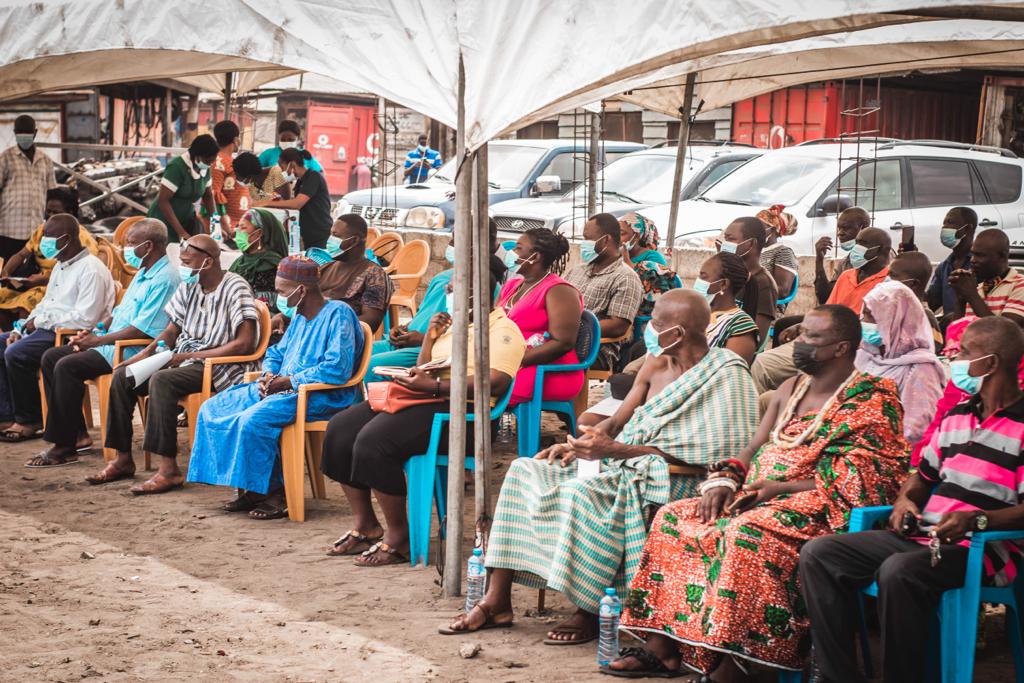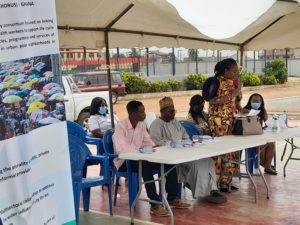
Blog: Understanding the Health Needs of the Vulnerable – Lessons from the Community
Delali Kumapley, Research Uptake Officer, CHORUS Ghana
Image credits – University of Ghana, School of Public Health
One of the main problems faced by the poorer populations living in informal settlements or slums is their inaccessibility to proper healthcare. Healthcare provision in informal settlements can be limited due to inadequate government resources and the nature and location of these settlements. Four such communities that face this challenge in Ghana are located in Ashaiman and La-Nkwantanang Madina in the Greater Accra Region. These communities are the focus of the Ghana “Community-Led Responsive and Effective Urban Health Systems” Research Programme (CHORUS).
In March 2022, four separate community entry events were organised by the CHORUS team in these municipalities to create awareness of upcoming project activities. Other aims of the engagement were to collectively understand the term ‘vulnerable groups’, including the health needs of the community as well as their accessibility to and relationship with health workers.
Participants of the community entry events ranged from leaders of relevant associations such as scrap dealers and mechanics groups; religious and tribal leaders, including chiefs, queen mothers (traditional female leaders), and Christian and Muslim leaders; as well as members of the local assembly/government, health workers and the local media.
Mixed groups comprising seven to ten members were formed to participate in breakout sessions.
Major Findings from the Community Engagement
After the breakout session, presentations were made by the various groups to the gathering and below are some of the major findings:
Vulnerable Groups and their Health Conditions
In the four project communities in Social Welfare, Madina Zongo, Fitterline and Taifa vulnerable groups were defined as individuals who needed assistance and they included children, the disabled, drug addicts, adolescents, homeless people and single mothers. These vulnerable groups of people as elicited from the discussions, were susceptible to both communicable and non-communicable diseases of which malnutrition, gastrointestinal conditions such as diarrhoea/cholera/typhoid, mental health challenges, hypertension and drug addiction/abuse were the most prevalent. A greater number of people in the vulnerable groups experienced malnutrition and other diseases that resulted from living in unsanitary conditions. Low income, busyness and the ready availability of cheap unwholesome food accounted for the prevalence of malnutrition among the vulnerable group. Community leaders reported that poor urban households are more likely to use non-formal forms of healthcare (drug peddlers, faith healers, herbal treatments and friends). This is because the formal sector is perceived as both expensive and inconvenient to access due to issues of long wait times at health facilities.
Relationship between Health Workers and Community Members
While a majority of the communities indicated that local government and health workers interacted with them on health-related issues they believed that the relationship could be better.
Most of the community members complained health workers were sometimes harsh and that prevented them from divulging sensitive information to them. Certain populations such as drug addicts, sex workers, street children/youth and school dropouts had weaker relationships with health workers. Some of them harboured the fear of being reported to the police by these health workers. Some of these groups were also perceived by health workers as being unwelcoming and potentially threatening the safety of health staff.
On the other hand, the aged, children and pregnant women had more cordial relationships with the health workers. In general, community members desired a better rapport with the health workers and advised that health workers be more approachable and professional in their dealings with vulnerable groups.
Suggestions on how to Improve Healthcare Provision in these areas
Members in these communities made the following recommendations on how formal healthcare provision could be improved to increase patronage by vulnerable groups:
- The cost of acquiring and renewing the National Health Insurance Scheme (NHIS) cards should be made more affordable, especially for vulnerable groups.
- The NHIS package must include a wider range of health services.
- Public health facilities should be established within communities or existing facilities be upgraded and improved with the government ensuring that these health facilities are adequately equipped with well-trained health workers who are available to cater to the needs of vulnerable groups.
- There should be an improved collaboration between the non-formal and formal healthcare sectors to aid in addressing the health needs of the vulnerable.
 These findings will set the ball rolling for the transect walks in each of the communities. The transect walks will give deeper insight into some of the issues that were raised by members of the community during the community engagement. Before the walk in each community, an orientation session will be conducted to discuss the main objectives of the walk, the ideal route and the boundaries of the community.
These findings will set the ball rolling for the transect walks in each of the communities. The transect walks will give deeper insight into some of the issues that were raised by members of the community during the community engagement. Before the walk in each community, an orientation session will be conducted to discuss the main objectives of the walk, the ideal route and the boundaries of the community.
Blog Author

Delali Kumapley is the Research Uptake lead for the CHORUS Ghana team, based at the University of Ghana, and is also the Research Uptake Officer for the consortium.